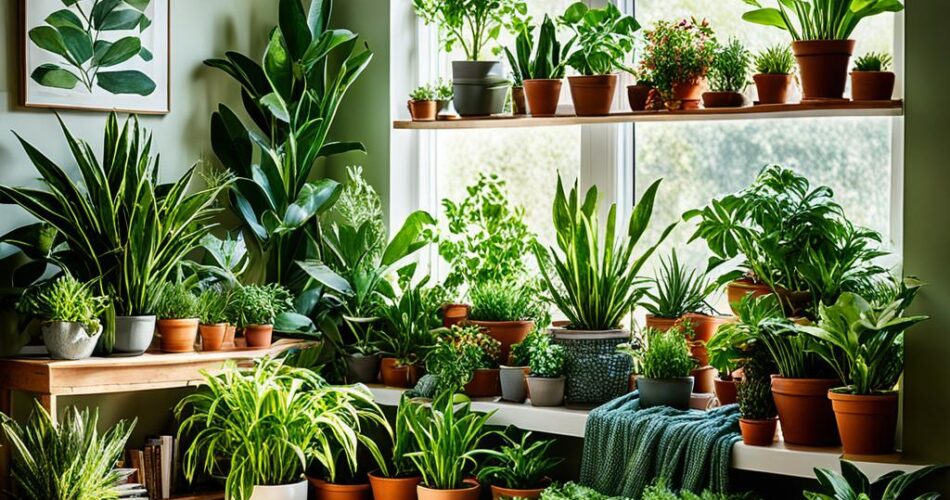Nature’s beauty can be embraced indoors with low light houseplants. Not all greenery demands abundant sunshine. Some varieties thrive as indoor plants for dim rooms. They brighten shadiest home corners.
Discover best shade-tolerant houseplants surviving and thriving in dimly-lit spaces. They offer low-maintenance care, easy upkeep, and pet-friendly options. These plants purify air while adding natural elegance.
Key Takeaways
- Low light houseplants can thrive in shady rooms with minimal sunlight exposure.
- Many varieties are beginner-friendly, air-purifying, and non-toxic to pets.
- From trailing vines to striking foliage, low-light plants offer diverse options.
- Proper care, including well-draining soil and appropriate watering, ensures success.
- Incorporating low-light houseplants enhances indoor ambiance and well-being.
Introduction to Low Light Houseplants
Sunlight is vital for plant growth. It enables photosynthesis and provides energy. However, not every home receives abundant natural light. Low-light houseplants are ideal for dimly-lit spaces.
Importance of Sunlight for Houseplants
Sunlight fuels photosynthesis in plants. This transforms light energy into chemical energy. This energy allows plants to grow and thrive. However, some varieties thrive in low-light conditions.
Defining Low-Light Conditions
Low-light conditions refer to areas with little to no direct sunlight. This includes rooms away from windows or north-facing spaces. Shade-tolerant indoor plants have evolved to flourish in dim environments.
Benefits of Low-Light Houseplants
Low-maintenance houseplants offer benefits beyond aesthetics. Plants for dark interiors improve air quality and create a calming ambiance. They introduce greenery into spaces lacking sunlight. They make ideal office plants for low light or houseplants for beginners.
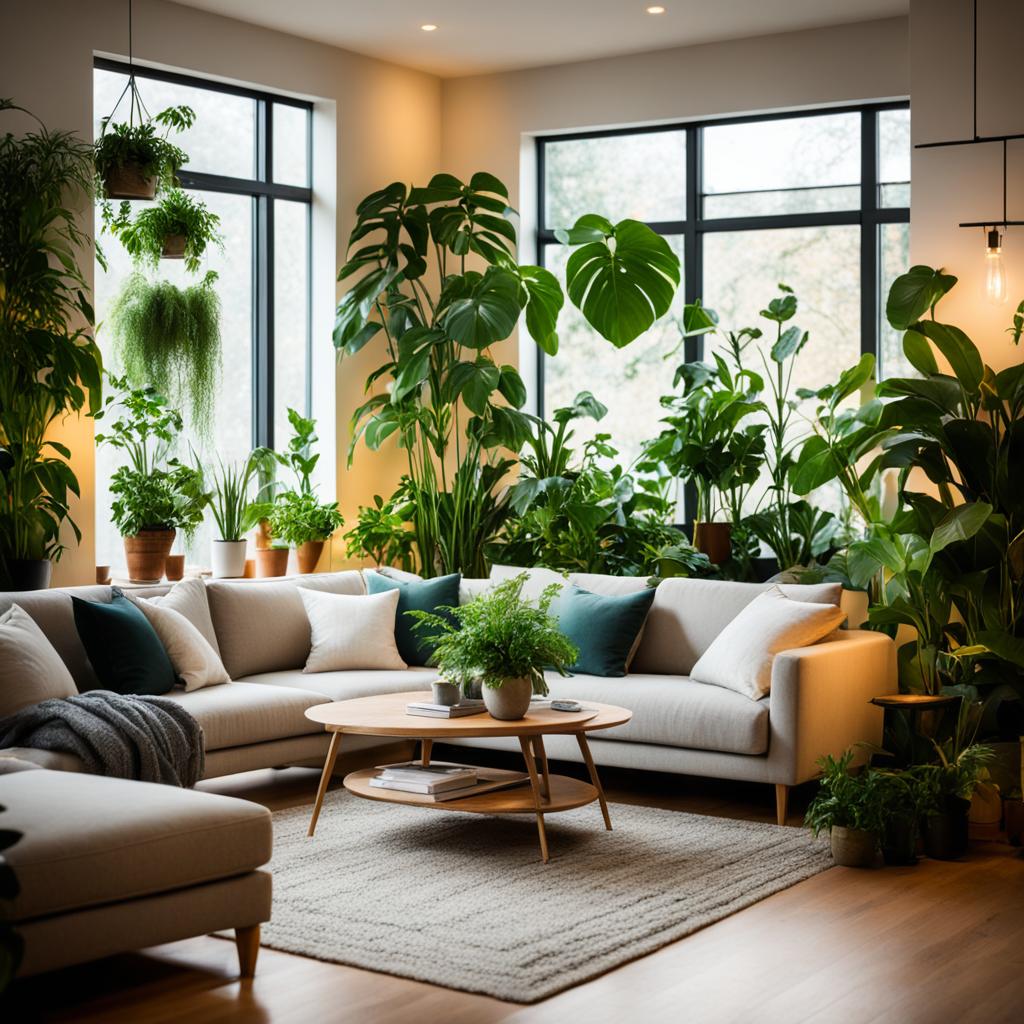
Drought-tolerant indoor plants thriving in dim conditions are perfect solutions. With proper low light plant care tips, transform shadiest corners with best houseplants for dark corners and office plant recommendations for low light.
| Low-Light Houseplant | Price Range |
|---|---|
| ZZ Plant | $35.00 – $195.00 |
| Sansevieria zeylanica | $33.00 – $60.00 |
| Golden Pothos | $21.00 – $68.00 |
| ‘Sweet Pablo’ Peace Lily | $72.00 |
| Aglaonema ‘Siam Red’ | $36.00 |
| Cast Iron Plant | $90.00 |
| Low Light & Air Purifying Plant Box | $260.00 (Discounted from $289.00) |
Fernwood Mikado
The Fernwood Mikado comes from the dracaena genus. It’s a smaller snake plant variety. This low light houseplant thrives with neglect. It’s perfect for dark rooms and shady spaces. It easily adapts to dim light conditions.
Unlike many shade-tolerant house plants, it has large root balls storing water. This allows easy drought tolerance. It’s truly low-maintenance for busy plant lovers or indoor gardening newbies.

Care Tips for Fernwood Mikado
- Provide bright, filtered light for optimal growth, but it can adapt to lower light levels.
- Use a well-draining, sandy soil mix to prevent root rot.
- Allow the soil to dry out completely between waterings, as overwatering can be detrimental.
- This slow-grower typically reaches a height of 75cm to 1m and can tolerate temperatures between 15°C to 23°C.
- Apply a weak cactus or general-purpose fertilizer once a month during the growing season.
- Be cautious as the Fernwood Mikado is mildly toxic if ingested, so keep it away from children and pets.
With its easy care and low-light tolerance, the Fernwood Mikado is ideal for adding greenery to your home’s dimmest corners.
Baby Rubber Plant
The baby rubber plant, scientifically called Peperomia obtusifolia, adds vibrant color to low-light spaces. These semi-succulent plants store moisture in stems and leaves, allowing them to survive in dim areas. With their colorful foliage and compact size, they make excellent desktop companions or cozy living space accents.
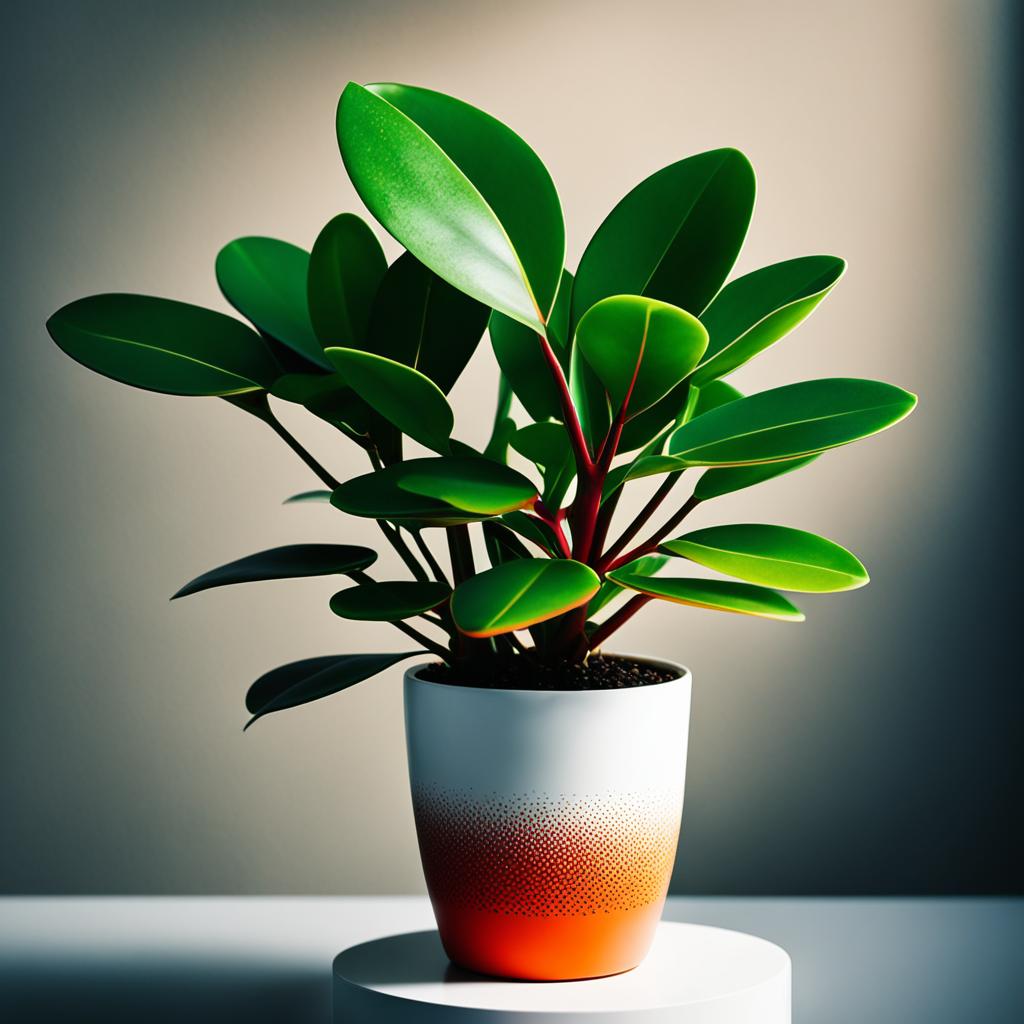
In 2022, the National Garden Bureau declared it the Year of the Peperomia, highlighting this genus’s incredible diversity. With over 1,000 species, Peperomia plants offer a range of leaf shapes and colors from tropical southern Florida, South, and Central America.
Peperomia Obtusifolia, the Baby Rubber Plant, can tolerate low light conditions.
While Peperomia prefers medium to bright indirect light, they adapt to dim light houseplant care routines. Water every 1-2 weeks, adjusting frequency based on light exposure. They thrive at 65°F to 75°F, remaining petite indoors, not exceeding two feet.
| Origin | Height | Light | Temperature |
|---|---|---|---|
| South America | 20cm – 30cm | Bright filtered light, tolerates medium and artificial lighting | 18°C – 26°C |
| Fertilizer | Propagation | Toxicity | Maximum Indoor Height |
| Well-balanced organic fertilizer monthly during Spring/Summer | Stem cuttings | Non-toxic | 12 inches |
Peperomia plants are easy to care for and resist most plant pests. They’re pet-friendly and non-toxic, ideal for homes with furry companions.
- Various baby rubber plant types have beautiful variegated leaves.
- Overwatering is common due to their succulent-like leaves.
- They grow moderately, benefiting from fertilization during active seasons.
- Repotting may be needed approximately every three years.
- These plants appreciate higher humidity, benefiting from misting or humidifiers.
- Dust accumulates on leaves and can be removed by wiping.
Silver Philodendron
The Silver Philodendron, known as satin pothos, is exceptional among dim lighting plants and plants for north-facing rooms. Its velvety leaves thrive without direct sunlight, making it ideal for energy-saving houseplants that add elegance to low-light settings.
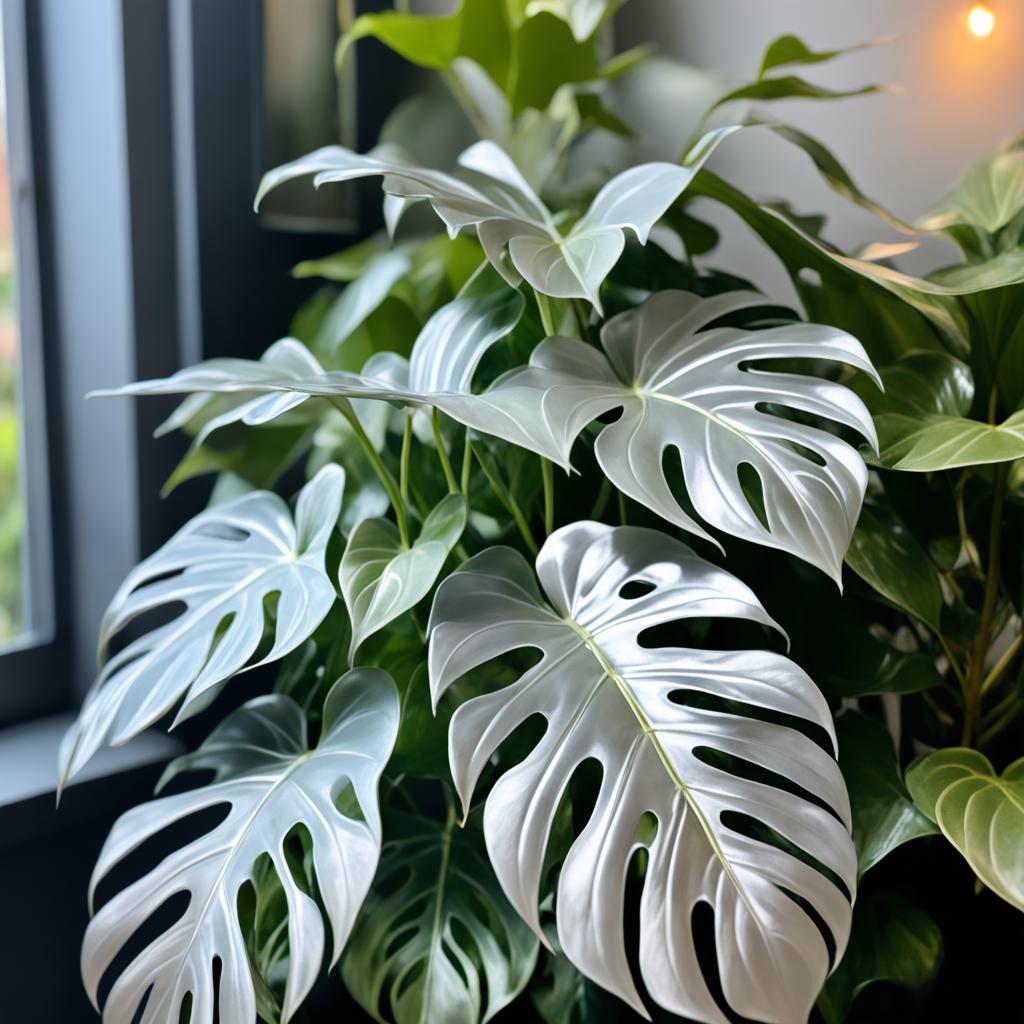
Caring for Silver Philodendron
The Silver Philodendron is low-maintenance. These easy-care foliage plants tolerate dry soil, allowing the top layer to dry before watering. Their trailing stems, up to 8 feet long, make them perfect for hanging baskets or indoor vines.
However, philodendrons are toxic if ingested, like 5 of the 14 low-light houseplants listed. Take precautions, especially with children or pets.
- Origin: South America
- Light preference: Moderate to bright indirect light; tolerates lower light conditions
- Watering recommendation: Allow soil to nearly dry out between waterings
- Humidity preference: Enjoys higher humidity due to large leaves
- Fertilization: Can be fertilized monthly during spring-summer with normal houseplant fertilizer
Customer reviews praise the Silver Philodendron’s health, packaging, and size, with a regular $20.00 price for this low-maintenance beauty.
Arrowhead Vine
The arrowhead vine, scientifically known as Syngonium podophyllum, is a Central American native. It thrives in low-light conditions, making it an ideal indoor plant for dimly lit rooms. Its foliage can range from bright green to bronze or variegated hues, adding natural beauty.
When young, it forms a bushy mound. Eventually, it develops trailing vines suitable for hanging baskets or training up a trellis. This versatile plant adapts to various environments, making it an office-friendly addition or a charming bedroom plant.
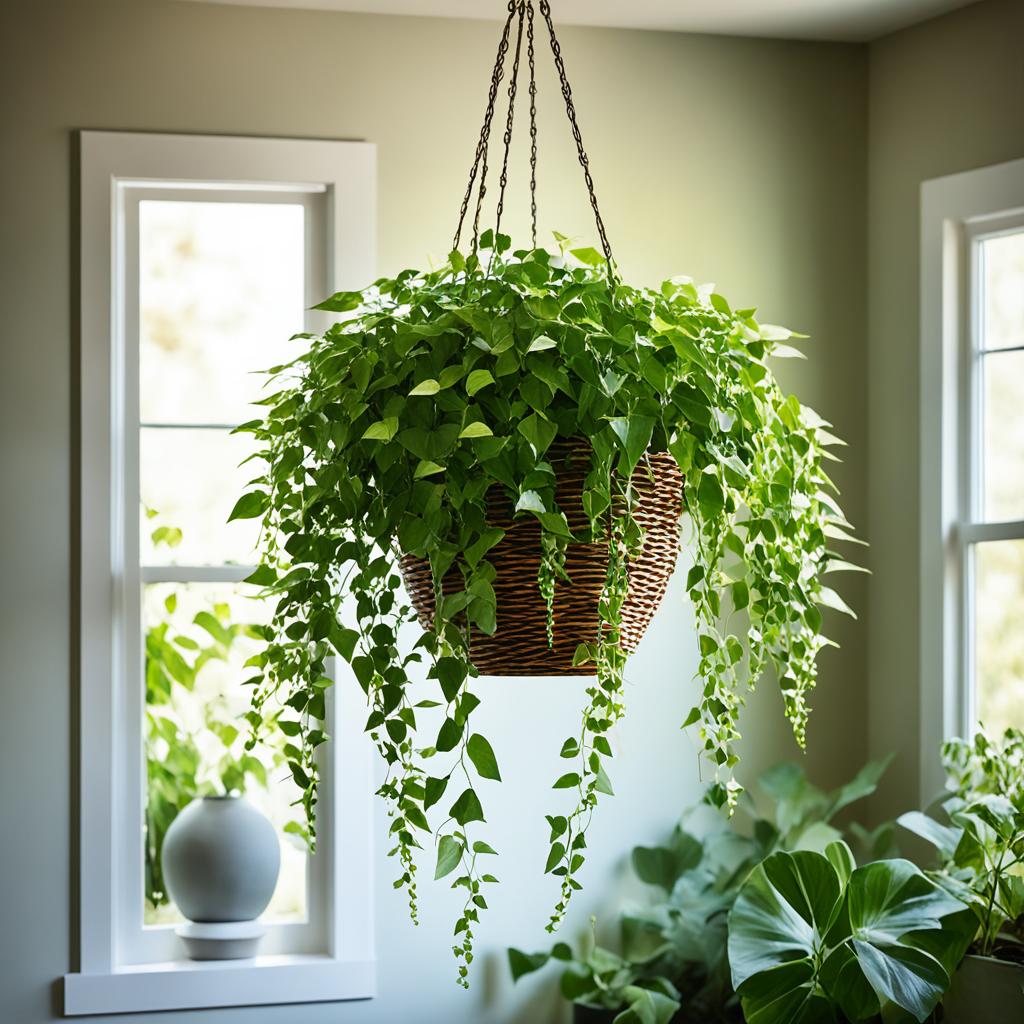
Despite its easygoing nature, the arrowhead vine has care requirements for successful growth. Repot every two years as the root system fills the pot. Fertilize sparingly, typically in spring and midsummer if growth slows.
Propagate via 4-inch stem cuttings showing new growth. Maintain temperatures between 60°F and 85°F year-round. Provide diffused light for a bushier plant, with an east or north-facing window ideal.
| Botanical Name | Common Name | Plant Type | Height | Width | Foliage Color |
|---|---|---|---|---|---|
| Syngonium podophyllum | Arrowhead Vine | Houseplant | 6 to 12 inches | 6 to 36 inches | Blue/Green, Purple/Burgundy |
While relatively low-maintenance, the arrowhead vine can be susceptible to common indoor pests like mites, mealybugs, aphids, and scale. However, it’s toxic to pets, so caution is advised when incorporating it into homes with furry friends.
Over the years, the arrowhead plant has maintained popularity as a houseplant. A growing number of cultivars are available, featuring shades of pink, lime green, and black, and varying textures like matte, shiny, or velvet.
Ferns for Low Light
Ferns offer graceful, hardy houseplants that thrive in partial shade. They add lush, tropical elegance to dimly lit spaces.
Bird’s nest ferns have unique nest-like fronds. Rabbit’s foot ferns sport fuzzy rhizomes, offering captivating textures.
The ever-popular Boston fern, with arching, feathery fronds, remains a classic office plant variety.
Types of Ferns for Shade
Ferns come in various sizes for any apartment or dorm. The petite Lemon Button Fern reaches 5-7 inches tall.
In contrast, the majestic Staghorn fern can spread up to 5 feet wide.
Humidity Requirements for Ferns
While tolerating low-light conditions, ferns require higher humidity. Preventing leaf drop or browning is essential.
Regular misting or pebble trays with water help maintain moisture levels. This ensures these NASA-approved air purifiers remain vibrant.
| Fern Variety | Height/Spread | Light Needs | Growth Habit | Humidity Preference |
|---|---|---|---|---|
| Lemon Button Fern | 5-7 inches tall, 4 inches wide | 12-14 hours of bright or indirect light | Mounding | High humidity |
| Staghorn Fern | Up to 5 feet wide, 3 feet tall | Bright filtered light | Epiphytic, spreads through fuzzy rhizomes | Moderate to high humidity |
| Boston Fern | 2-3 feet tall and wide | Bright indirect light | Upright clumping | High humidity |
Neon Pothos
The neon pothos’ vibrant green and variegated foliage adds color to living room plants. This easy-care indoor plant offers a lively presence in home plant varieties.
Its stunning addition to dim spaces remains tolerant of low-light conditions.
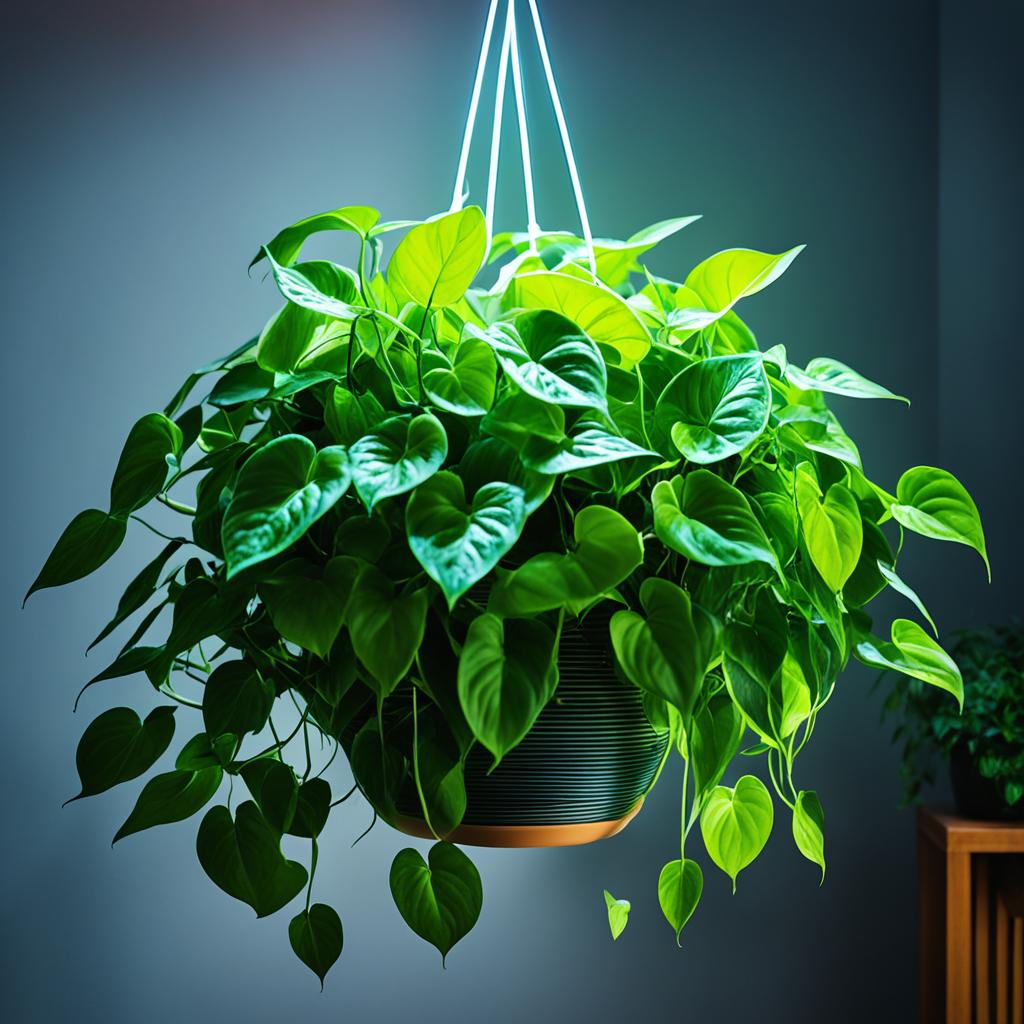
Preventing Root Rot in Neon Pothos
However, the neon pothos is prone to root rot when not receiving sunlight. To prevent this issue, allow the soil to dry out between waterings.
Avoid overwatering this low-maintenance indoor plant. It thrives in slightly drier conditions.
Exercise caution when hydrating the neon pothos to prevent root rot.
| Plant Characteristic | Neon Pothos |
|---|---|
| Light Requirements | Medium to low indirect light |
| Watering Frequency | Every 1-2 weeks, allow soil to dry slightly |
| Temperature Range | 60-80°F (15-27°C) |
| Fertilization | Monthly with general-purpose indoor plant fertilizer |
| Maximum Size | Up to 8 inches tall and 40 feet wide |
By understanding the neon pothos’ specific requirements, you can enjoy this plant. Its vibrant foliage remains stunning in low-light settings while minimizing root rot.
Grape Ivy
Grape ivy, also known as oak leaf ivy, is a stunning and versatile low light indoor plant. Its trailing foliage, in various green shades and unique shapes, adds elegance to shaded spaces. It’s an excellent choice for office plants low light or bedroom plants low light.
Grape ivy’s standout feature is tolerating dim light plants conditions. This resilient plant thrives in minimal natural light areas, making it ideal for north-facing rooms or spaces lacking ample sunlight.
Training Grape Ivy
Grape ivy’s trailing stems beautifully lend themselves to various training methods, accentuating your indoor space’s aesthetic. Consider hanging baskets for cascading vines, trellises or totems for climbing stems, or trailing planters for whimsical visual interest.
- Hanging baskets: Let vines cascade over edges, creating a lush focal point.
- Trellises or totems: Train stems to climb up, creating living art with depth and texture.
- Trailing planters: Position ivy in elevated planters, allowing vines to trail down.
Maintain lush appearance by watering regularly, keeping soil evenly moist but not waterlogged. This adaptable plant tolerates humidity range, making it low-maintenance for busy households.
| Grape Ivy Care Tips | Ideal Conditions |
|---|---|
| Light Requirements | Low to bright, indirect light |
| Temperature Range | 68°F to 82°F (10°C to 28°C) |
| Soil pH | 5.5 to 6.2 (slightly acidic) |
| Watering Needs | Allow soil to dry slightly between waterings |
| Humidity Tolerance | Moderate to high humidity |
With striking foliage, adaptability to low-light conditions, and ease of care, grape ivy adds natural beauty to indoor spaces like living rooms, offices, or dimly-lit bedrooms.
Calathea
Calatheas, known as prayer plants, make captivating living room and dark room plants. Their patterned leaves and vibrant hues add decorative beauty to shaded spaces. While requiring extra care, their unique charm appeals to low light houseplant enthusiasts.
The calathea family offers over 20 species with distinct foliage patterns and colors. The Calathea orbifolia, with pinstriped leaves unfurling like praying hands, is a favorite. Other popular varieties include Calathea medallion, ‘Freddie’, peacock plant, ornata ‘Beauty Star’, rufibarba, and vittata.
Varieties of Low-Light Calatheas
The calathea family boasts over 20 species, each offering a distinct foliage pattern and color palette. The Calathea orbifolia is a favorite among plant enthusiasts, with its striking pinstriped leaves that unfurl like a hand opening in prayer.
Caring for Low-Light Calatheas
Calatheas tolerate low light conditions and thrive in shady corners with specific care. They need high humidity, ideally 50% or higher, achieved through misting or pebble trays. These plants prefer filtered or distilled water and soil drying slightly between waterings.
A well-draining, organic-rich potting mix is best, blending potting soil, orchid bark, charcoal, and perlite. Calatheas prefer temperatures between 60-75°F (16-24°C). With proper care, these stunning low light houseplants can bring tropical flair to dimly lit home spaces.
Low Light Plant Arrangements
Bringing greenery into shady areas or windowless decor isn’t difficult. With the right dim light tolerant houseplants, you can craft stunning displays that brighten any dimly-lit space. Consider these creative arrangements for showcasing shade loving indoor plants:
Terrariums and Dish Gardens
Terrariums and dish gardens offer a captivating way to display indoor plants for shady areas. These miniature gardens allow combining various drought tolerant houseplants in one container, creating a vibrant display. The enclosed space helps maintain higher humidity, which many low-light plant care varieties prefer.
Hanging Baskets and Wall Planters
Maximize vertical space in dimly-lit areas with hanging baskets or wall planters. Fill them with trailing or cascading houseplants for shaded rooms. Varieties like pothos, philodendrons, or grape ivy make excellent choices.
These displays add depth and texture to bare walls or dark corner plants. Hanging planters position plants closer to light sources, ensuring necessary exposure.
| Plant | Light Tolerance | Arrangement |
|---|---|---|
| Pothos | Low to Moderate | Hanging Baskets, Wall Planters |
| Philodendron | Low to Bright, Indirect | Terrariums, Dish Gardens, Hanging Baskets |
| Grape Ivy | Low to Moderate | Hanging Baskets, Wall Planters |
| Ferns | Low to Moderate | Terrariums, Dish Gardens |
With these creative arrangements, you can transform dimly-lit corners into lush spaces. Windowless decor greenery is achievable with the right plant choices and displays.
Conclusion
Embracing low-light houseplant varieties transforms dimly-lit home corners into lush oases. Trailing pothos and philodendrons vines, vibrant calatheas and aglaonemas foliage offer beginner-friendly, easy-care options. Many are drought-tolerant, thriving in low-moisture, making them excellent low-maintenance greenery choices.
Beyond aesthetic appeal, several low-light houseplants act as natural air-purifying allies. Ferns not only add tropical shaded space elegance but also improve air quality. Incorporating these versatile plants creates a serene, breathable atmosphere while adding nature indoors.
Whether opting for classic ZZ plant, trendy Maranta, or enchanting shade-loving terrarium, low-light houseplants offer possibilities. Embrace resilience, enjoy easy care, let these verdant beauties transform living spaces into rejuvenating retreats – even dimmest settings.
